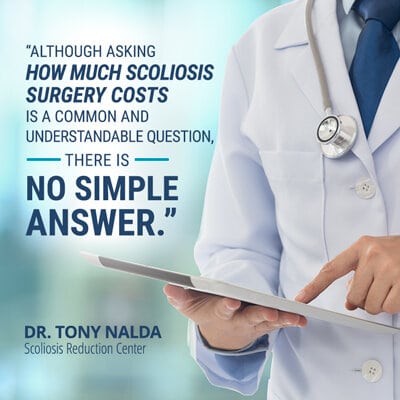Scoliosis surgery, specifically spinal fusion, represents a significant decision for those managing this complex condition. With its ability to correct spinal alignment and halt the progression of scoliosis, the cost of this procedure is a major consideration for patients and their families.
When it comes to the cost of spinal-fusion surgery for scoliosis, it can range anywhere from $100,000 to $250,000. There are a lot of variables that go into determining the final price such as hardware, length of hospital stay, condition severity, and whether or not there are additional complications.
In the following article, we will explore the various factors that contribute to the wide range of scoliosis surgery costs, offering insight into what patients can expect when considering this treatment option, as well as alternatives to scoliosis surgery. From hospital fees to the price of post-operative care, understanding these elements is crucial for making an informed decision about proceeding with scoliosis surgery.
4 Key Takeaways
- High Cost of Spinal Fusion Surgery: The cost of spinal fusion surgery for scoliosis can range from $100,000 to $250,000, influenced by various factors including hardware used, length of hospital stay, condition severity, and potential complications.
- Consideration of Non-Monetary Costs: Beyond the financial burden, spinal fusion surgery carries emotional and physical costs, including the impact on quality of life, flexibility, and the potential long-term worry about hardware in the back.
- Alternatives to Surgery: While spinal fusion has been a traditional approach to treating scoliosis, alternative, non-invasive treatments offer potential for curvature reduction without the significant costs and risks associated with surgery.
- Importance of Exploring All Treatment Options: Given the complexity of scoliosis and the significant implications of surgery, patients and caregivers are encouraged to thoroughly investigate all available treatments, including innovative non-surgical approaches, to make an informed decision tailored to their specific circumstances.
The Traditional Treatment Approach
When it comes to treatment plans for patients with scoliosis, there are two main approaches: the traditional orthopedic method and the chiropractic-centered method.
The traditional orthopedic approach is well-established and represents the dominant conservative approach, but that doesn’t necessarily mean it’s the best choice. This approach is reactive and relies on observation, bracing, and surgery.
Whether you’re a proponent of spinal-fusion surgery as a treatment method for scoliosis or not, it can’t be denied that it’s an invasive and costly procedure. If it’s so invasive and costly, you might be wondering why so many people still end up relying on it to treat their scoliosis.
One of the reasons is that, when compared with how long spinal-fusion surgery has been the dominant approach, chiropractic-centered alternative treatment approaches such as ours at the Scoliosis Reduction Center® are quite modern and innovative.
As is the case with most areas of life, progress and change take time. While some scoliosis specialists will always funnel their patients towards surgery because they truly believe it’s the best way to fix a spinal curvature, more and more doctors, specialists, and patients are informing themselves on the different approaches available.
As people inform themselves and are empowered with knowledge, the ideology behind treating scoliosis is beginning to shift as people recognize there are more than just monetary costs associated with spinal-fusion surgery.
Observation and Reaction
The traditional treatment approach relies heavily on observing and reacting. What this means for you, the patient, or caregiver of a patient, is that watching and waiting will be the primary tenet of your treatment plan.
Traditional approaches would diagnose a patient, and if the Cobb angle measurement places the condition on the mild or moderate designation, the recommendation would likely be that there is a mild curvature present but that it should be observed to see if it gets worse; this is known as progression.
The ideology here is to observe the patient’s rate of progression, and when it has progressed to a certain degree, surgery is recommended as ‘necessary’. In cases where the patient comes to the specialist with a severe scoliosis curvature or diagnosis, surgery can be presented as the only option because of how much the condition has already progressed.
To simplify, a patient’s condition is watched, sometimes paired with bracing, and then its’ progression is reacted to in the form of costly and invasive surgery.
Variables that Affect the Price of Scoliosis Surgery

Although asking how much scoliosis surgery costs is a common and understandable question, there is no simple answer as every case is different. There are a large number of variables that can affect the cost of spinal-fusion surgery.
With fluctuation in mind, a ballpark estimate on the cost of scoliosis surgery would be between $100,000 and $250,000. According to debt.org, the average cost of spinal fusion surgery in 2018 was $110,000; that estimate can increase dramatically with the following variables.
Some of the most important variables that can affect the surgery’s cost includes hardware, length of hospital stay, condition severity, and whether or not there are any additional complications.
Hardware
The amount and type of hardware used in a spinal-fusion surgery can have a big impact on the final cost. In addition to sometimes using bone or bone-like material, metal plates, rods, and screws are used to hold the vertebrae together with the goal of them healing into one solid unit.
Depending on what types of hardware are used and the amounts of that hardware, the cost of the surgery can fluctuate. Surgeons are often paid on a per-screw basis.
Length of Hospital Stay
With any surgery, the length of the hospital stay will affect the final cost. Health care is a big business, and when it comes to the cost of hospital stays before and after surgery, every case is different.
According to debt.org, in 2017, daily hospital costs averaged $3,949, with average hospital stays costing $15,734. Those are some big numbers, and keep in mind, those are the averages. Imagine how those numbers can skyrocket when unexpected complications come into play.
With approximately 60 percent of bankruptcy cases in the States being tied to medical expenses, you can see why costly surgeries, if they can be avoided, are not always the best option.
The following areas are surgery-related costs that fluctuate to determine final price:
- Hourly costs of using operating rooms
- Anesthesia
- Individual surgeon’s fees
- Cost of pre-surgery prep and hospital stays during recovery
- Pre-surgery treatment
- Consultations with the surgeon pre- and post-surgery
- Insurance deductibles
Condition Severity
It’s a good rule of thumb that the more serious a condition is, the more complex the surgical procedure to fix it will be. With a spinal curvature that is severe, measuring 40-plus degrees for adolescents and 50-plus for adults, the more hardware is likely necessary, the more invasive the procedure, the more time it will take to complete the surgery, and more than likely, the longer recovery time in the hospital will be.
For some individuals, more than one surgery could be necessary. Surgeons can do what’s called an anterior-and-posterior approach where they go in through the front to cut the ligaments and loosen the spine; then they do a second surgery to go in through the back to put the hardware, such as rods and screws, in. Obviously, in these cases, you’re looking at the mounting costs of multiple surgeries.
Additional Complications
Every surgery, no matter how minor, carries risks. While surgeons have their patient’s best interests at heart, sometimes complications happen in the operating room that are unavoidable. Any complication will equal more time spent in the hospital, more medications used, and as discussed, hospital care and stays don’t come cheap.
Some potential complications that can occur during, or as a result of, spinal-fusion surgery include:
- Insufficient wound healing
- Infection
- Bleeding
- Blood clots
- Damage to the spine’s nerves and blood vessels
- If a bone graft is taken, excessive pain at the site of removal
- Paralysis
Unforeseen Costs of Surgery for Scoliosis
If you or a loved one is calculating the cost of spinal-fusion surgery, additional costs that aren’t necessarily tied to the surgery itself, but still impact other areas of life, are often forgotten.
If you have children and need childcare while you recover from surgery, those costs can accumulate quickly. If you have to miss work, you might have missed wages to contend with.
Let’s not forget the emotional costs of undergoing an invasive procedure like spinal-fusion surgery. The worry leading up to the surgery for the patient and their loved ones can be intense, and those first days following the surgery can be fraught with pain and emotional instability. Recovery can be a long road, longer for some than others, depending on health and wellness prior to surgery.
While spinal-fusion surgery is most often successful in terms of making a spinal curvature straight, or straighter, long-term effects are different for everyone. How the hardware ages with the rest of the body and potential costs in terms of flexibility and range of motion can be high, and these factors should also be considered carefully when deciding on a potential treatment plan.
What some patients and caregivers don’t realize is that there are non-monetary costs associated with scoliosis surgery that can claim their price over time. People who have to constantly worry about the rod in their back can find that worry affecting their quality of life. Having the confidence to try new things or participate in new activities can be a challenge for people who have undergone spinal-fusion surgery; that’s a hard thing to put a price on.
Paying for Surgery Costs

For those living on a budget or without health insurance, paying for surgery can be a life-altering event. Even with good coverage that pays up to 80-percent, with a surgery as potentially costly as spinal-fusion, a person can still have to pay a large sum out of pocket.
If you add unforeseen complications onto that bill, a patient on limited funds can face the possibility of bankruptcy to cover the mounting bills related to additional doctor’s visits, medications, X-rays, physical therapy, and time spent in the operating room and the hospital during recovery.
For people struggling with how to pay for spinal-fusion surgery, these are some commonly-used options:
- Borrowing from retirement savings
- Medical crowdfunding
- Payment plans
- Draining savings
- Using home equity
- Unsecured loans
While none of these options are particularly ideal, many people have been put in the position of having to rely on one or more of the above financial methods to cover the bills associated with costly spinal-fusion surgery.
Conclusion
Surgery definitely has its place within the health-care industry; I’m not disputing that. What I am questioning is the necessity of invasive spinal-fusion surgery in the majority of scoliosis cases. In my view, spinal-fusion surgery for treating scoliosis is a last resort. Let’s not forget that spinal-fusion doesn’t cure scoliosis: nothing can do that. It only holds the spine in a straighter alignment through artificial and invasive means.
While an estimate of $100,000 to $250,000 can be given for the cost of scoliosis surgery, initial estimates can increase dramatically when unexpected additional complications or lengthy hospital stays arise.
If you or a loved one is facing a recent scoliosis diagnosis, I highly recommend you do your due diligence and look into every treatment option available to you. My book, Scoliosis Hope, is a great resource for those interested in what dynamic and innovative scoliosis treatment approaches have evolved.
What I want every person with a scoliosis story to know is that there are options other than simply watching and waiting until the condition has progressed to the point that surgery is recommended as the ‘best’ option. My scoliosis-specific chiropractic approach is 100-percent patient-focused. Without surgery, my patients have achieved curvature reductions while maintaining their flexibility and range of motion, without draining their bank accounts.





